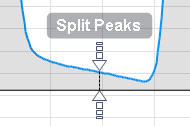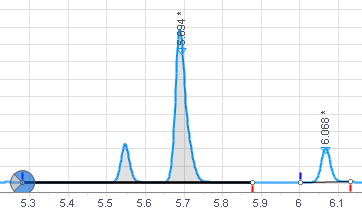Manual integration
These options allow you to switch on and off various functions and tools. Only the enabled tools will be used.
What do you want to do?
Manual integration options
Apply manual integration | Selected, if the Manual Integration icon |
Activate attractors | Attractors are usually visible on the signal and at baseline points of the adjacent elements. When the cursor approaches an attractor it will be automatically snapped by it.
|
Show active attractors | If you move a baseline point, an attractor helps you to position the point on the baseline. When the cursor approaches the baseline, an attractor with snapped-in cursor is shown.
|
Show baseline annotations | Start and end points of each baseline segment are shown with blue ( |
Show command hints | Show the name of the currently active manual integration tool.
|
Show point selector | Show the integration wheel when the mouse is moved over a baseline point.
|
Fill active peaks | If the mouse is above an integrated peak, highlight the corresponding peak.
|
Show drop line annotation arrows | If you move the mouse over a drop line, an additional double arrow for moving the drop line is shown.
|
Highlight active drop line | If the mouse is above or over a drop line, highlight the corresponding drop line.
|
Manual integration tools
|
New baseline | The New baseline tool is automatically activated when you move the mouse cursor below the signal in an area without any integrated peaks. Left click and drag will create a new baseline segment. |
|
New nested baseline | The New nested baseline tool is similar to the New baseline tool. With this tool you can integrate shoulder and rider peaks. It is activated when you move the mouse cursor below the signal in the area of an integrated peak where no other nested segments are defined. |
|
Merge baseline segments | The Merge baseline segments tool is active if the mouse is under a common baseline point between two baseline segments. With this tool, the baseline will be drawn as a straight line from the start of the first baseline segment to the end of the second baseline segment. |
|
Merge peaks | The Merge peaks tool is active if the mouse is above a drop line. With a left click, the two drop line separated peaks will be merged together. |
|
Delete peaks |
With this tool, you can right-click in an integrated peak and select Delete peak from the context menu. |
|
Delete range | With this tool, you can delete the integrated peaks in a manually selected range. Keep the Shift key pressed while you click and drag the mouse over the range. |
|
Change baseline type |
With this tool, you can open a context menu for a nested baseline and select its type. |
|
Move baseline point | This tool is part of the Integration Wheel. If you move the mouse close to a start point or end point of a baseline segment, the blue Move baseline point tool is activated. This allows to move the respective baseline point to a new position. The Move baseline point tool is also available for drop points within a baseline segment. In this case the segment will be split into two parts when the point is moved to a new position. |
|
Move common baseline point | This tool is part of the Integration Wheel. It is shown as a red section in the Integration Wheel. With this tool, you can move a baseline point that is common to the peaks on both sides. Both baseline segments and all of their associated peaks are modified. |
|
Move drop line | If the mouse cursor is moved close to a drop line, the Move drop line tool is activated. The drop line can be moved to a new position by click and drag. |
|
New connected baseline | This tool is part of the Integration Wheel. The gray New connected baseline tool allows to create a new baseline segment that directly starts at the active baseline point of an existing baseline. The end point of the new segment can be freely positioned. |
|
Split peaks | The Split peak tool is active if the mouse is above an integrated peak. Left click will split by inserting a drop line. |
|
Select peak | The Select peak tool is active if you move the mouse cursor over the marker at the top of a peak. |
See Also
base-id: 11015127051
id: 11015127051
 is clicked in the Chromatograms toolbar.
is clicked in the Chromatograms toolbar.

 ) and red (
) and red ( ) markers.
) markers.



